How Do You Connect Cast Iron Service Weight Pipe?
Cast Atomic number 26 Soil Pipe & Fittings Handbook
Chapter two - Installation of Bandage Iron Soil Pipage and Fittings
Joining Methods for Cast Iron Soil Pipe
Compression Gaskets
At that place are generally three methods used for joining cast iron soil pipe. Hub and spigot cast iron soil pipe may exist joined by the compression gasket or a caulked joint. Hubless bandage iron soil pipe are joined past using a hubless coupling. The compression gasket is a precision molded one-piece gasket that is made of an elastomer that meets the requirements of ASTM C-564. The concrete characteristics of this elastomer ensures that the gasket will not disuse or deteriorate from contact with the materials flowing in the pipe or chemicals in the soil or air around the piping. The pinch joint is made as follows:
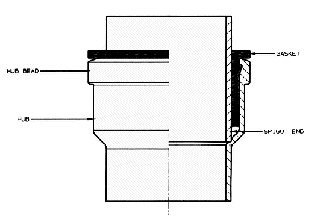
- Clean the hub and spigot and so they are reasonably free from dirt, mud, sand, gravel or other foreign materials. When installing pipe that has been cutting, make sure the sharp edge is removed. The sharp edge may jam against the gasket's seals making joining very difficult. The sharp edge may exist removed past filing or tapping the border with a ball-peen hammer.
- Fold and insert the gasket into the hub. The gasket must exist inserted into the hub completely. Only the flange which contains the identification information remains exposed on the outside of the hub.
- Lubricate the articulation following the manufacturer's recommendations. Sizes 2" through fifteen" may be lubricated using a manufacturer's recommended lubricant. Some manufacturers recommend using an agglutinative lubricant on large bore pipe and fittings (five"-15"). It should be noted that use of the adhesive lubricant does non accept the identify of proper bring together restraint when required.
- Align the pipe and so that it is straight. Using the tool of your selection, button or pull the spigot through all of the sealing rings of the gasket. Y'all volition feel the spigot end of the pipe lesser out in the hub. Fittings may be installed past using the tool of your option or by driving the fitting abode past using a lead maul. To practice this, strike the fitting on the driving lug or across the full hub. Hit it every bit hard equally necessary, the lead volition deform without harming the fitting. Using the lead maul is the fastest and easiest mode to install fittings on hub and spigot bandage iron soil piping. Proper safety procedures should be observed in making the articulation.
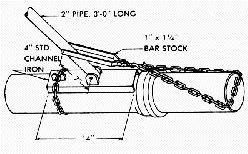
Hubless Joints
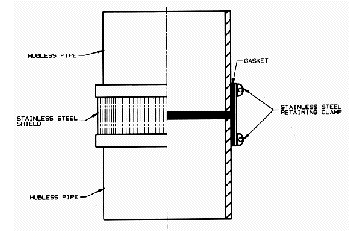
Hubless cast atomic number 26 soil pipe is joined by using the hubless coupling. Several different types of hubless couplings are available. The following will outline the installation procedures of hubless couplings that run into the requirements of CISPI 310. It must be noted that these installation procedures are not intended to be applicable for couplings other than those manufactured in accord with CISPI 310. These couplings are manufactured using a stainless steel shield and clamp assembly and an elastomeric sealing sleeve conforming to the requirements of ASTM C-564. The post-obit steps should exist taken to ensure a proper joint.
- Place the gasket on the stop of one pipage or fitting and the stainless steel clamp and shield associates on the cease of the other pipe or plumbing fixtures.
- Firmly seat the pipe or fitting ends confronting the integrally molded center cease inside the elastomeric sealing sleeve.
- Slide the stainless steel shield and clamp assembly into position over the gasket and tighten the bands. The bands should exist tightened using a calibrated torque wrench set at lx in./lbs. For larger diameter couplings that have four bands, the inner bands should exist tightened first then the outer bands tightened. In all cases, when tightening bands they should be tightened alternately to ensure that the coupling shield is fatigued upwards uniformly.
Caulked Joints
Prior to the late 1950'south, the caulked joint was the simply method of joining hub and spigot cast fe soil piping. To make a caulked articulation the following steps are used:- The spigot end of a pipe or fitting is placed within the hub of another pipe or plumbing equipment making sure that both are clean and dry.
- Oakum is placed in the joint using a yarning fe and then packed to the proper depth by using the packing atomic number 26. For specifying depth of atomic number 82 for each size and grade run across table beneath.
- Molten atomic number 82 is and then poured into the joint. The molten atomic number 82 is brought up to the tiptop of the hub.
- After the pb has solidified and cooled somewhat, the joint is ready to be caulked. Caulking is performed with inside and outside caulking irons. Caulking the joint sets the pb and makes a leak-gratuitous articulation.
Atomic number 82 and Oakum Required to Caulk Cast Iron Soil Pipe Joints
Oakum is made from a vegetable fiber and used for packing hub and spigot joints. Cotton and hemp tin can too be used. These materials are ordinarily twisted loosely into strands or braided and formed into a round or rectangular cross section. A rough dominion-of-thumb method for estimating oakum requirements is to take 10 percent of the weight of the lead required for caulking. Table v provides a more than authentic method for estimating oakum requirements. 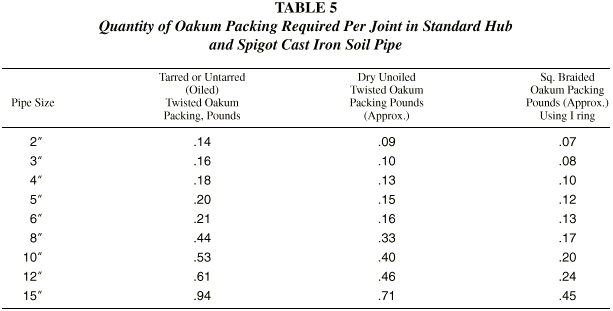
Atomic number 82 quantities can exist roughly estimated past rule-of-thumb every bit 12 ounces per inch of diameter as a minimum. Thus a iv inch diameter pipe would require three pounds of lead as a minimum. An 8 inch diameter pipe would require vi pounds of lead. This allows for skimming-off and for a reasonable loss due to spillage in pouring. Table vi lists suggested lead quantities for various pipe and plumbing fixtures diameters. The amounts shown utilize only to cast iron soil pipe and fittings fabricated co-ordinate to ASTM Standard A-74.
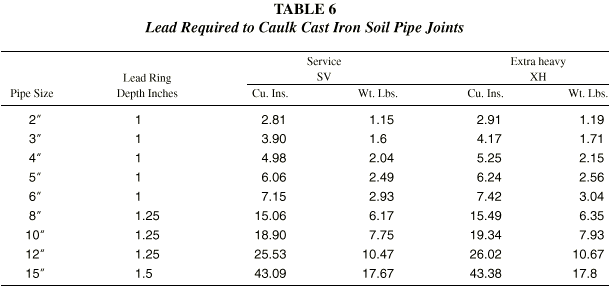
The standards of the Lead Industries Association contain the specification for lead quality. Atomic number 82 for caulking purposes should contain not less than 99.73 percent of lead and no more than the post-obit maximum commanded impurities: .08 pct copper, .002 pct zinc, .002 per centum iron, .25 per cent bismuth, .02 percentage silver, and a full of not more than 0.15 pct arsenic, antimony and tin. The melting bespeak for caulking lead is 621 degrees F, and the proper pouring temperature is 790 - 830 degrees F. The lead is ready for pouring when it becomes a cherry red. After cooling, there is a shrinkage of approximately v.viii percent from the liquid state.
Note: The caulked joint is a very time consuming method of joining cast iron soil pipe. The vast bulk of all hub and spigot cast atomic number 26 soil piping installed today is joined by using the compression gasket.
Handbook Tabular array of Contents
Source: https://www.lawsupply.net/cast_iron/spec/chapter4c.htm
Posted by: garciamanneve.blogspot.com


0 Response to "How Do You Connect Cast Iron Service Weight Pipe?"
Post a Comment